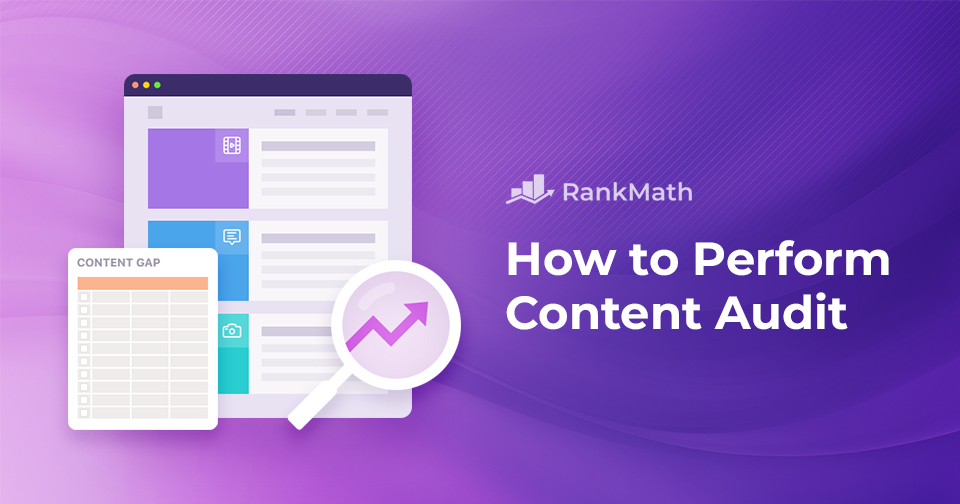So, you’ve got this fantastic WordPress site with awesome content, amazing design, and all the bells and whistles.
But have you ever wondered what’s going on with all that content you’ve been creating?
As the volume of content grows, ensuring its relevance, accuracy, and effectiveness becomes very important. This is where the concept of a content audit within WordPress comes into play.
In this post, we’ll discuss the ways to improve your content’s performance with regular content audits. So, without any further ado, let’s get started.

Table Of Contents
1 What is Content Audit?
A content audit is a strategic and systematic assessment of all the content assets within a website.
During a content audit, various types of content, such as articles, blog posts, images, and videos, are reviewed. The primary objective is to gain insights into the effectiveness of the existing content strategy.
For instance, imagine you’re running a health blog and have a post titled “10 Best Vegan Protein Sources”. A content audit will involve reviewing this post, along with others, to evaluate whether it’s still useful, accurate, optimized for SEO, and aligned with your current content strategy.
2 Importance of Content Audit
Content audits allow the identification of high-performing content that resonates with the audience. Recognizing what works well provides valuable insights for future content creation and helps capitalize on successful strategies.
On the flip side, content audits help flag underperforming content. Whether it’s due to low engagement or outdated information, knowing what needs improvement enables organizations to enhance or repurpose content for better results.
Content audits contribute to SEO efforts by identifying keywords, optimizing metadata, and uncovering opportunities for building authoritative backlinks, thereby improving the website’s rankings.
3 How to Do a Content Audit
Let us now discuss the steps by which you can perform your audit.
3.1 Define Goals and Objectives
Identify the purpose of your content audit.
For instance, you want to increase organic traffic and improve engagement on the blog 10 Best Vegan Protein Sources.
Once the purpose is defined, setting specific goals provides a roadmap for the audit process. These goals should be measurable, achievable, and aligned with the purpose. Specifically, for the post “10 Best Vegan Protein Sources”, your goals can be:
- Update outdated information (published in 2022).
- Improve SEO rankings for keywords like “vegan protein” and “plant-based protein.”
- Reduce bounce rate and increase time-on-page.
- Boost conversions (e.g., newsletter sign-ups or ebook downloads).
3.2 Create an Inventory
One of the fundamental steps in a content audit is creating an inventory.
The first task is to take stock of the diverse range of content on your website. This includes blog posts, videos, images, and other content that populate your online space. By creating a comprehensive list, you get a complete view of your content, ensuring no valuable piece is left unaccounted for.
Also include the specific URLs where each piece of content resides, as well as the titles and publication dates. This additional information brings context to your inventory, making it a dynamic resource for analysis.
You can either create an inventory manually via an Excel or Google Sheets spreadsheet, or you can use an online tool like Semrush or Screaming Frog.
For our example, the inventory can look like this:
| URL | Title | Publish Date | Word Count | Target Keyword |
| /vegan-protein-sources | 10 Best Vegan Protein Sources | Jan 2022 | 1,200 | vegan protein |
Once your inventory is ready, Rank Math’s CSV Import/Export feature makes it easy to export the data and keep everything organized for further review and optimization, tying your audit into the next steps of your SEO workflow.

3.3 Collect and Analyze Data
Begin by pinpointing key performance indicators (KPIs) essential to understanding your content’s impact.
Metrics such as page views, time on page, bounce rate, and conversion rates serve as foundational elements. These KPIs offer insights into the effectiveness of your content and user engagement.
Utilize diverse data sources to compile a comprehensive dataset. This includes leveraging analytics tools such as Google Analytics, social media analytics, and email campaign metrics.
Navigate to your Google Analytics account and open Reports → Engagement → Pages and Screens, as shown below. Here, you can track all the key metrics for your pages.
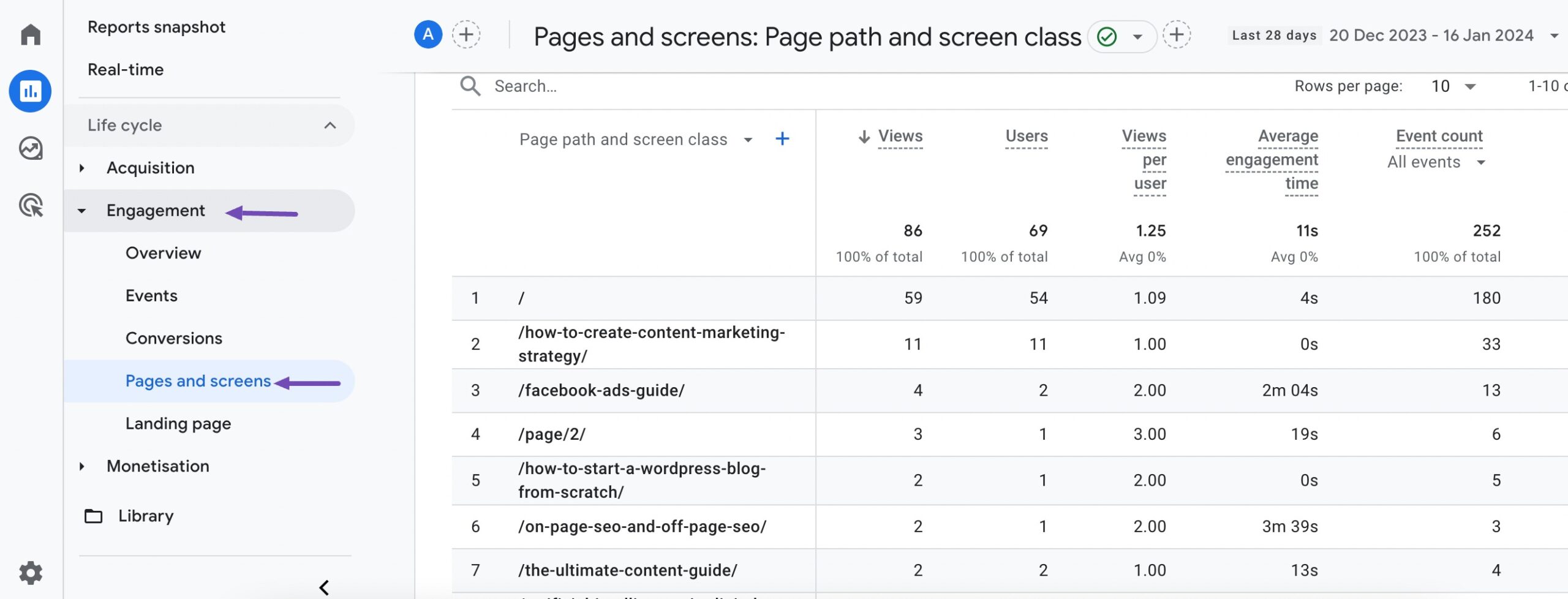
You can also use Google Search Console to track CTR and impressions to understand how your content is performing in the search. Look for content in the Performance tab of Google Search Console that is not performing well and update it.
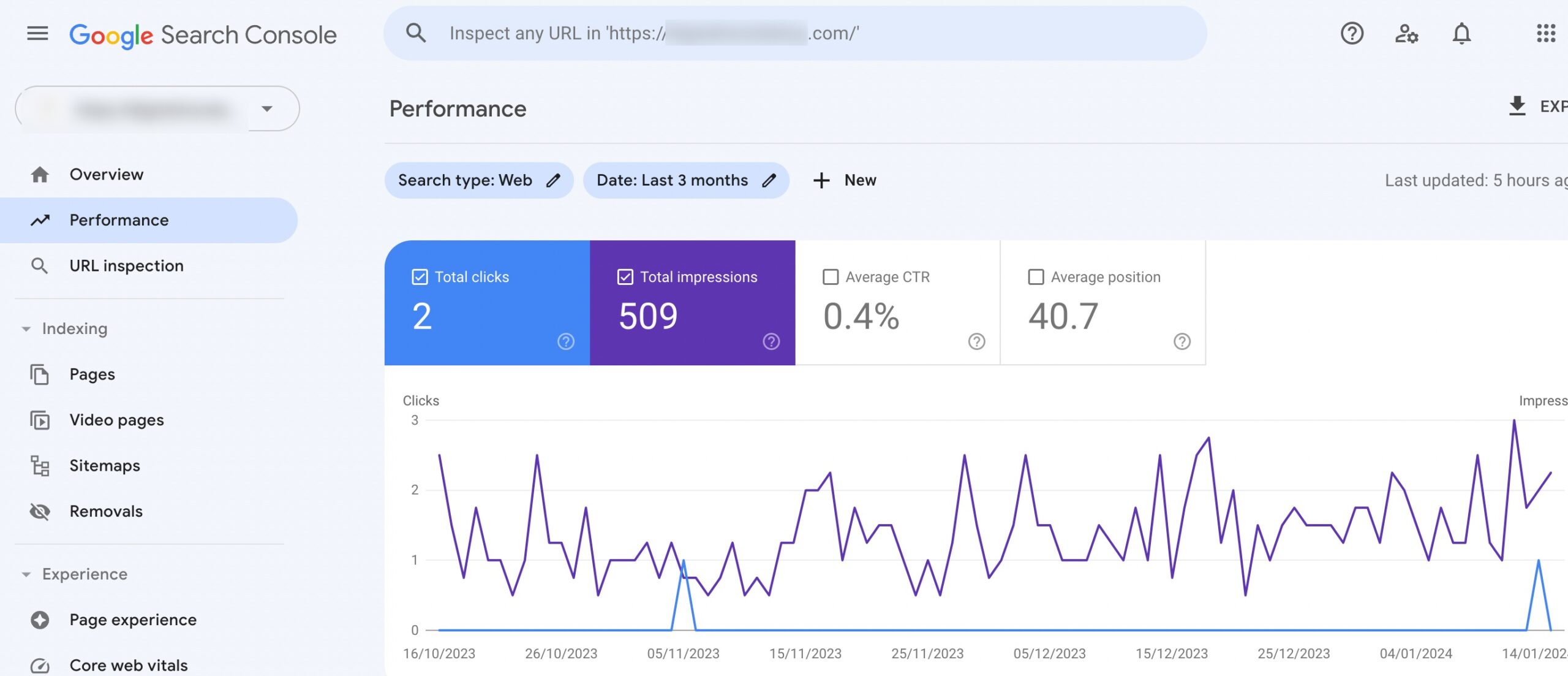
Also, assess both the quality and quantity of the backlinks. Identify backlinks that contribute positively to your website’s credibility and search engine ranking.
For instance, for our example post, you find:
- Pageviews (last 30 days): 10,000
- Bounce rate: 75% (too high)
- Avg. time on page: 1 min (could be better)
- Ranking keyword: “vegan protein” (position #12)
- CTR: 2.4%
- Backlinks: 3 (from vegan forums and health blogs)
- Conversion rate: 0.3% (low newsletter sign-ups)
So we can interpret that the post 10 Best Vegan Protein Sources is getting traffic, but readers are leaving quickly, and it’s not ranking in the top 10. Hence, it’s time for improvements.
It is also important to examine the content to ensure it aligns with the search intent. By closely aligning content with search intent, you not only enhance the relevance of your content but also contribute to a more positive user experience. Rank Math PRO helps you optimize content by revealing the intent behind your primary keyword.
Additionally, evaluate your competitors’ content to identify areas and strategies for enhancing your performance.
Now, do a qualitative review of the actual blog post.
- Is the content up-to-date? (No – nutrition facts are from 2021.)
- Is it visually appealing? (No images, no infographic.)
- Is the search intent matched? (Partially – lacks depth.)
- Is it optimized for SEO? (Meta description is generic, headings could be improved.)
- Does it link to other relevant blog posts? (No internal links.)
- Is it mobile-friendly? (Yes.)
You can create a content audit spreadsheet to keep track of all the details in one place, as shown below.

3.4 Create an Action Plan
Once you’ve evaluated your content, create a strategy to enhance its performance.
Begin by pinpointing the specific areas of your content that require improvement. This can be based on engagement metrics, user feedback, or alignment with your objectives. The goal is to identify the low-hanging fruit and important aspects that will contribute significantly to overall improvement.
Your action plan should align with your business goals. Consider how the proposed changes in your content strategy will contribute to achieving these objectives.
For instance, an action plan for “10 Best Vegan Protein Sources” will look like:
| Issue | Solution |
|---|---|
| Outdated stats | Replace with 2025 USDA data |
| No visuals | Add an infographic and images of each protein source |
| Low rankings | Optimize headings and add related keywords (e.g., “plant-based protein”) |
| High bounce rate | Embed a video from your YouTube channel: “How to Cook with Vegan Proteins” |
| Low conversions | Add a CTA for a free “Vegan Protein Cookbook” download |
| No internal links | Add links to “Vegan Meal Plan” and “Protein-Rich Vegan Snacks” posts |
Whether it’s increased brand visibility, higher conversion rates, or improved user satisfaction, every action should be a step toward fulfilling your goals.
3.5 Adjust Your Content Marketing Strategy
Monitor your content’s performance, celebrating wins and learning from setbacks. By keeping track of your content’s performance, you can adjust your strategy to meet the needs of your audience and generate good results in search engines.
Here are a few tips you can consider for your content marketing strategy:
- Learn from your top-performing content when assessing your less successful pieces.
- Examine your competitors’ content to find areas for improvement in your performance.
- Regularly review and audit your content strategy at least once a year.
4 Deleting and Redirecting Content
Deleting and redirecting outdated content is an essential step in a content audit to maintain a website’s relevance and SEO performance.
Removing a piece of content beyond repair—whether due to outdated information, discontinued products, or obsolete guides—can help search engines recognize that your website is actively maintaining high-quality content.
However, before deleting any page, it’s important to consider its SEO value, particularly in terms of backlinks and internal links.
If a page has accumulated many backlinks or serves as a key internal link hub, deleting it outright can lead to a 404 error, negatively impacting SEO. Instead of abruptly removing such a page, a better approach is to implement a 301 redirect.
To set up a 301 redirect using Rank Math, ensure the Redirections module is enabled in the plugin’s settings.

Once activated, access the Redirections section, add the old URL as the source, and specify the destination URL where users should be redirected. Select the 301 permanent redirect option to retain the SEO benefits.
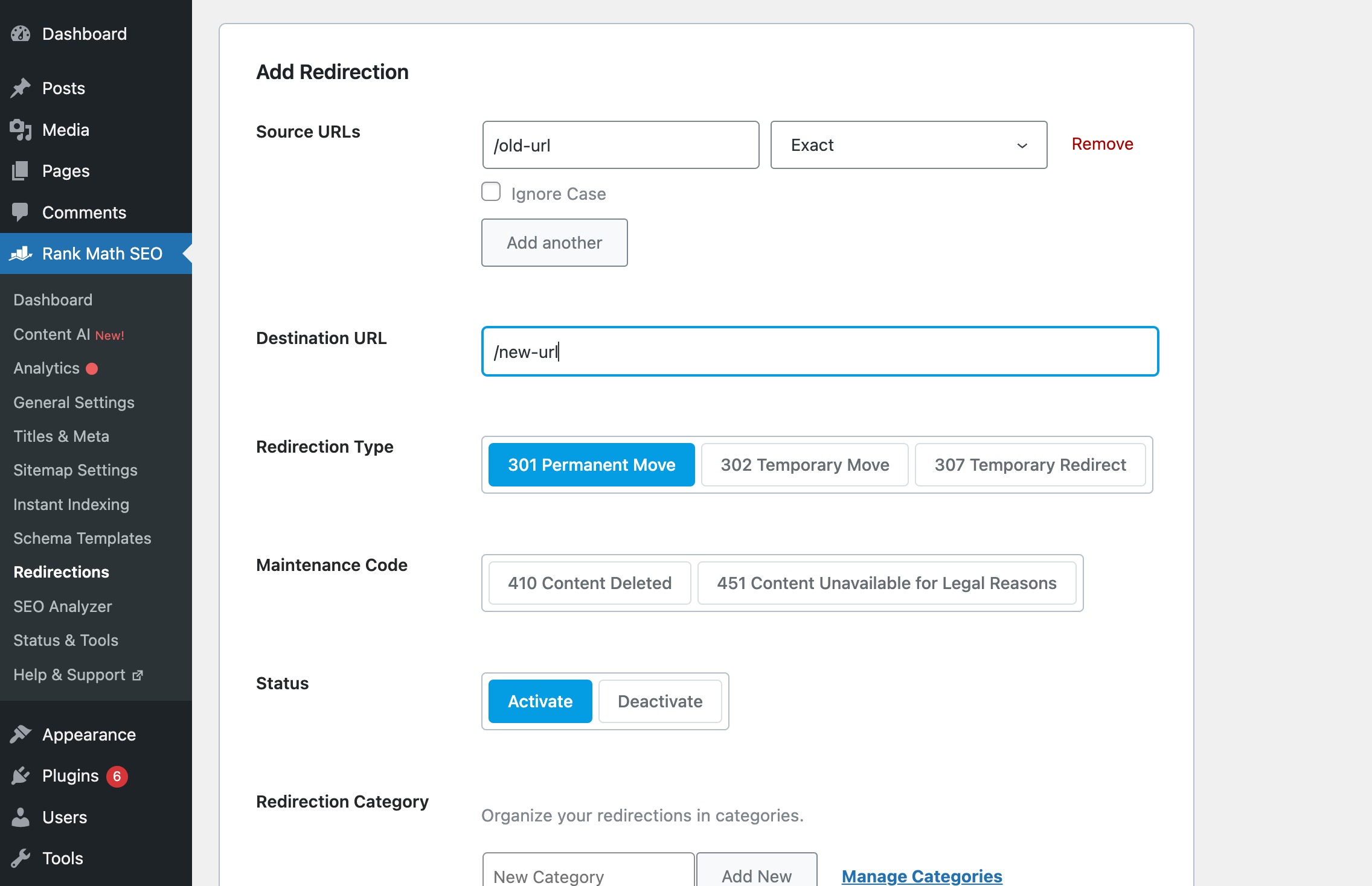
Refer to our dedicated tutorial on setting up Redirections in Rank Math.
Keeping the redirection active for at least six months to a year before completely removing the content helps search engines process the change effectively.
5 Combining Content for an Effective Content Strategy
When conducting a content audit, you may find that some articles on your website cover similar topics or compete for the same keywords.
Instead of maintaining multiple overlapping pieces, combining them into a single, more comprehensive post can improve SEO and enhance user experience.
This process involves merging content from older or redundant pages into a stronger, well-structured article and then implementing a 301 redirect from the outdated pages to the new one.

A useful way to identify content that should be merged is by analyzing Google Search Console. If multiple pages rank for the same keyword, but one page has significantly lower impressions and clicks, it may be a candidate for consolidation.
Additionally, if your content includes yearly updates—such as event results or industry trends—it’s useful to maintain a single evergreen page that is updated annually.
With Rank Math, you can automate the process of updating the SEO title to reflect the current year dynamically, eliminating the need for manual edits each time a new year begins. Navigate to your post or page, and in the General tab of Rank Math meta box, select the variable %currentyear% to update the current year.
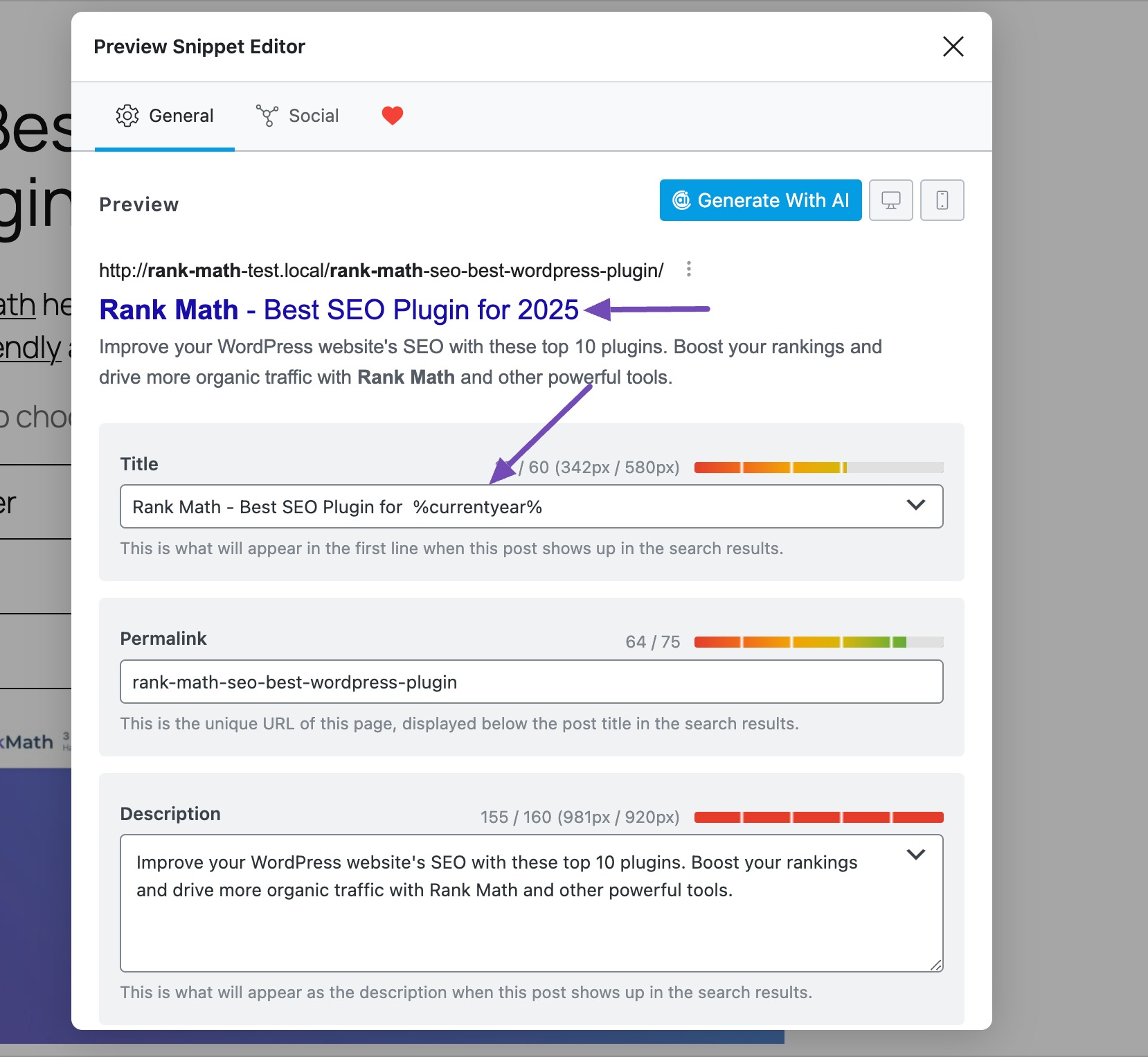
6 Updating Content for an Effective Content Audit
Search algorithms favor fresh content, so regularly revising old posts can help maintain and improve rankings. Updating content involves adding new insights, improving readability, optimizing for current search intent, and refreshing outdated statistics or references.
Instead of removing an underperforming post, revising it with better information, enhanced formatting, and additional media like images or videos can breathe new life into it.
Rank Math’s RankBot simplifies content optimization by providing AI-driven suggestions for improving SEO. RankBot can analyze existing content and recommend actionable improvements based on real-time search trends and competitor insights when performing a content audit.
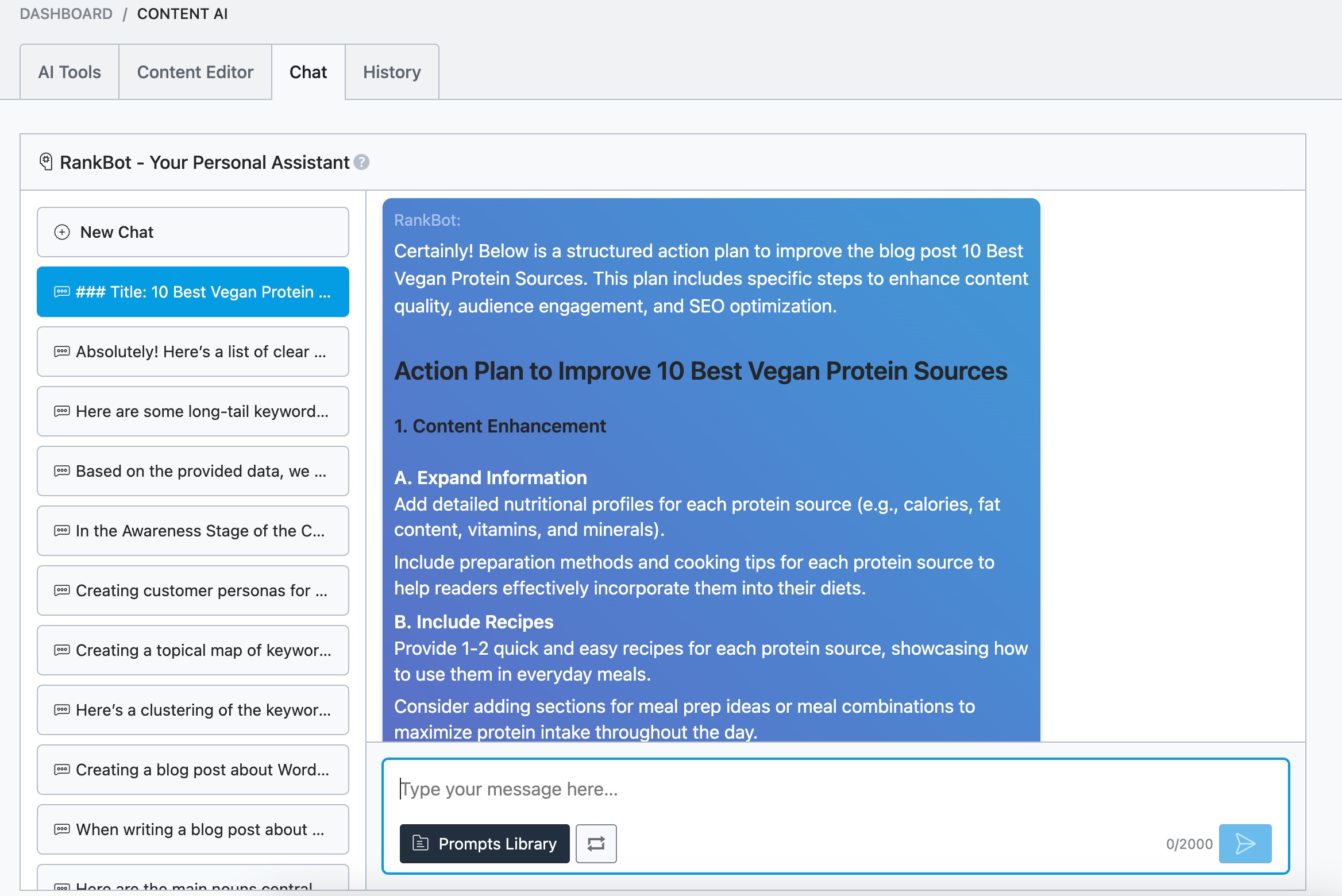
Start applying your action plan. For instance:
- Rewrite parts of the intro and update nutrition stats.
- Add alt-text optimized images.
- Improve the SEO title:
Before: “10 Best Vegan Protein Sources”
After: “Top 10 Vegan Protein Sources (2025) – Plant-Based Nutrition Guide” - Include internal links to related articles.
- Add a lead magnet CTA: “Download our Free Vegan Protein Chart.”
7 Content Repurposing
Content repurposing is an effective strategy to extend the reach and lifespan of existing content by adapting it for different formats and platforms.
If a blog post or article that once generated significant search traffic is now declining—possibly due to changes in user behavior or platform preferences—repurposing can help revive its visibility.
Rank Math’s Content AI simplifies the repurposing process by offering AI-driven tools designed to generate content for multiple platforms.
Within the Marketing & Sales category of Content AI, you can create social media posts, video scripts, and promotional content tailored to different audiences.
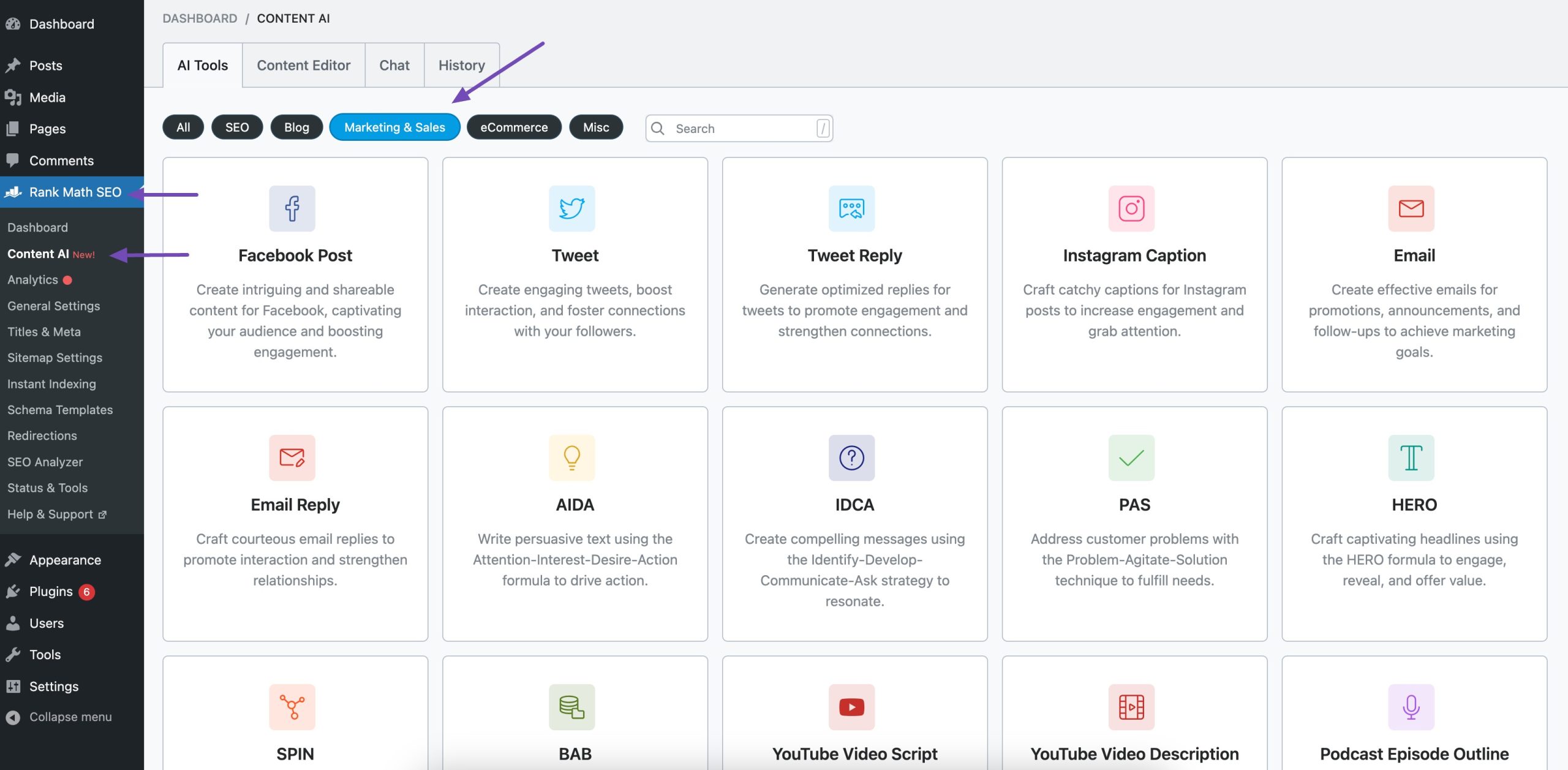
For instance, if you want to convert a blog post into a tweet, you can input the article’s title, select an appropriate tone (e.g., friendly or conversational), and let Content AI generate engaging tweet variations, complete with relevant hashtags.
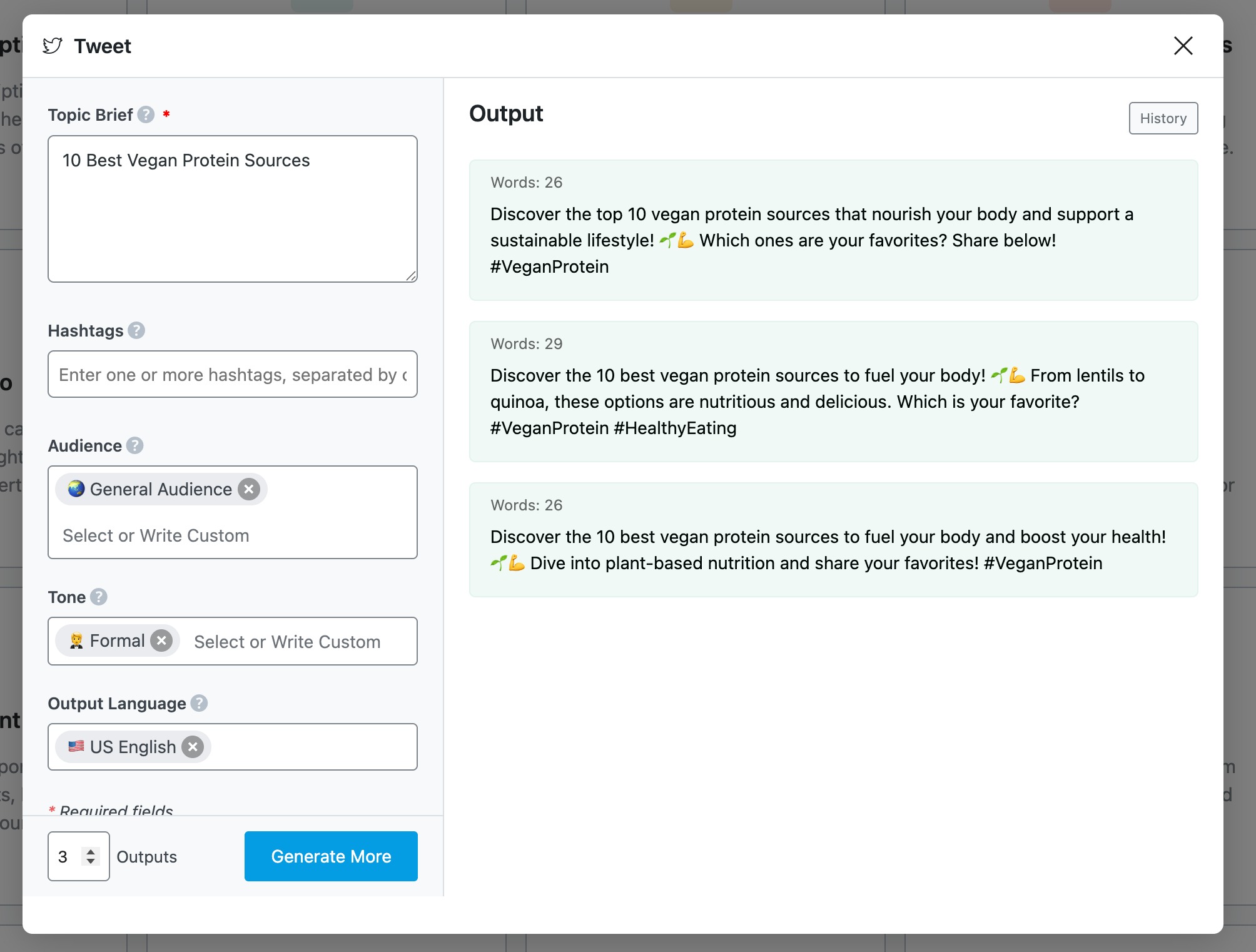
Similarly, if you want to create captions for Instagram or video scripts for YouTube, Content AI provides structured suggestions, ensuring your content maintains consistency while adapting to each platform’s unique style.
Using these tools, you can maximize the potential of existing content without starting from scratch, ultimately driving more traffic and engagement across multiple channels.
8 Frequently Asked Questions
How often should I conduct a content audit?
Conduct a content audit at least once a year to keep your content strategy aligned with changing business goals and evolving audience preferences.
What metrics should I consider during a content audit?
Key metrics include page views, bounce rate, time on page, conversion rates, and social shares. These metrics provide insights into content performance.
How do I identify outdated content during an audit?
Look for content with outdated information, expired promotions, or broken links. Check for relevance and update or remove accordingly.
How can I improve content that performs poorly?
Identify the weaknesses in underperforming content, update information, improve visuals, and enhance user experience to boost performance.
Can a content audit help with content repurposing?
Absolutely, a content audit identifies evergreen content that can be repurposed, saving time and maximizing the value of existing content.
How do I handle content that no longer aligns with business goals?
Consider archiving or removing content that no longer supports your current objectives to maintain strategic alignment.
9 Conclusion
A content audit isn’t just something you do once and forget — it’s an ongoing process that keeps your content strategy effective.
By celebrating successes, learning from shortcomings, and adapting to changing industry trends, you set the stage for content that not only performs well today but will continue to shine in the future.
When done right, a content audit helps you stay relevant, boost your SEO performance, and get more out of the content you already have. So take the time to review, refresh, and realign your content.
Embrace the insights gained, implement improvements, and watch your content strategy flourish. Here’s to a future of compelling, relevant, and high-performing content!
Keep improving, stay consistent, and your content will continue to deliver value, not just today, but well into the future.
If you like this post, let us know by Tweeting @rankmathseo.
